2023/3/24
Cherry blossom can be enjoyed around Nara city center from the latter part of March through to late April. Why not take a leisurely stroll around Nara, once the capital, cloaked in cherry blossom. There is a palpable sense of history.
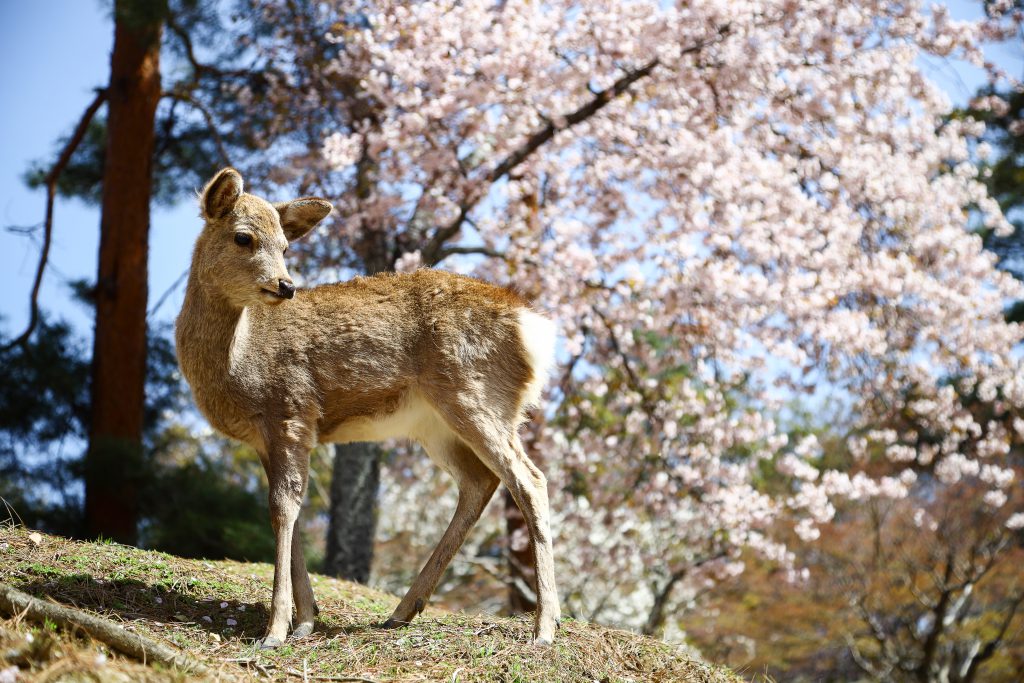
Kasugano Park has views, to the east, of Wakakusayama Hill and, to the northwest, Tōdaiji Temple’s Great Buddha Hall. Recommended because of the juxtaposition of the broad grassy area with grazing deer, and the rows of cherry trees. Enjoy the essence of spring in Nara in this beautiful setting.
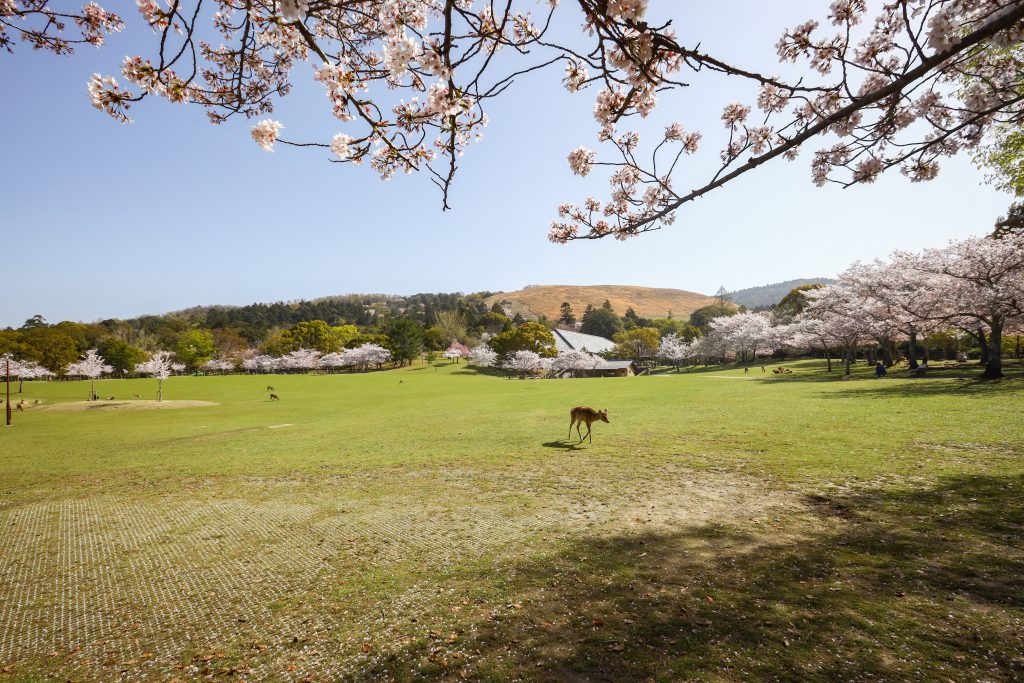
Kasugano Park cherries and deer, set against Wakakusayama Hill to the east.
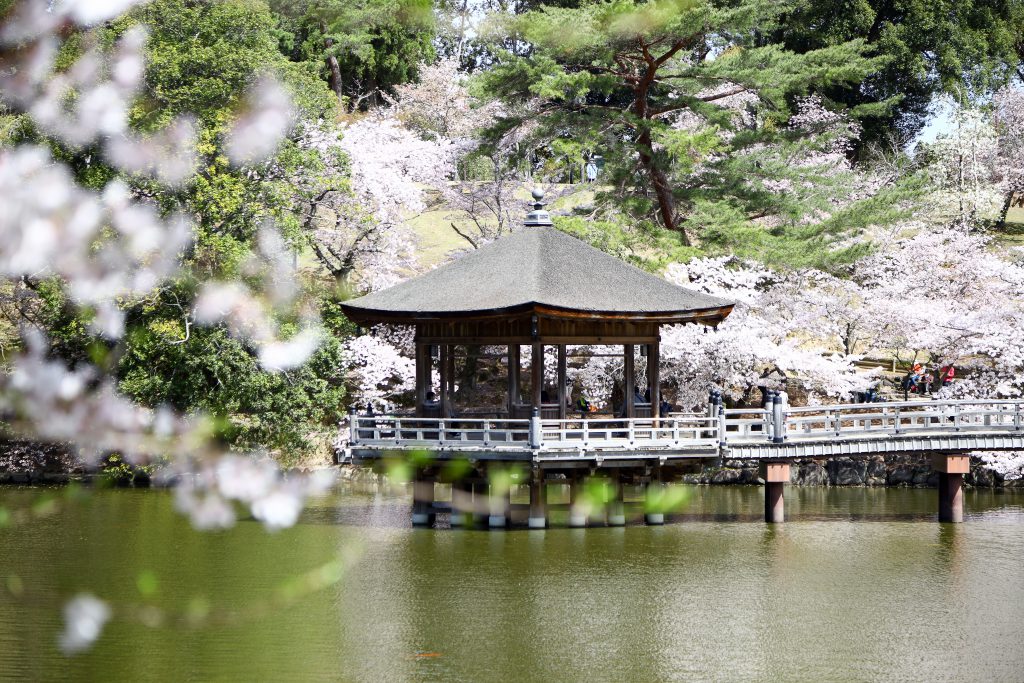
Cherry blossom at the Ukimidō, illuminated at night.
The hexagonal Hakkakudō-style Ukimidō Gazebo, which appears to float on Sagi-ike Pond, offers fine views of cherry blossom on the banks reflected in the pond. This one of the finest double cherry blossom viewing spots in the city. Hiring a boat to see the blossom from the water is delightful.
The Nara no Yaezakura double cherry is the Nara Prefectural flower, and appears on Nara City crest. One variety, the Chisoku-in Nara no Yaezakura, is a designated National Natural Monument. The tree was originally discovered at Chisoku-in Temple in the precincts of Tōdaiji Temple, and was designated a National Natural Monument in 1912 (Taishō 12). Blown down in strong winds in 2009 (Heisei 21), it lived on thanks to a ‘Chisoku-in Nara no Yaezakura’ regeneration project in 2013 (Heisei 25). Trees propagated from this one now blossom in and around Tōdaiji Temple, Nara Park, and Kōhfukuji Temple. We urge you to seek them out!
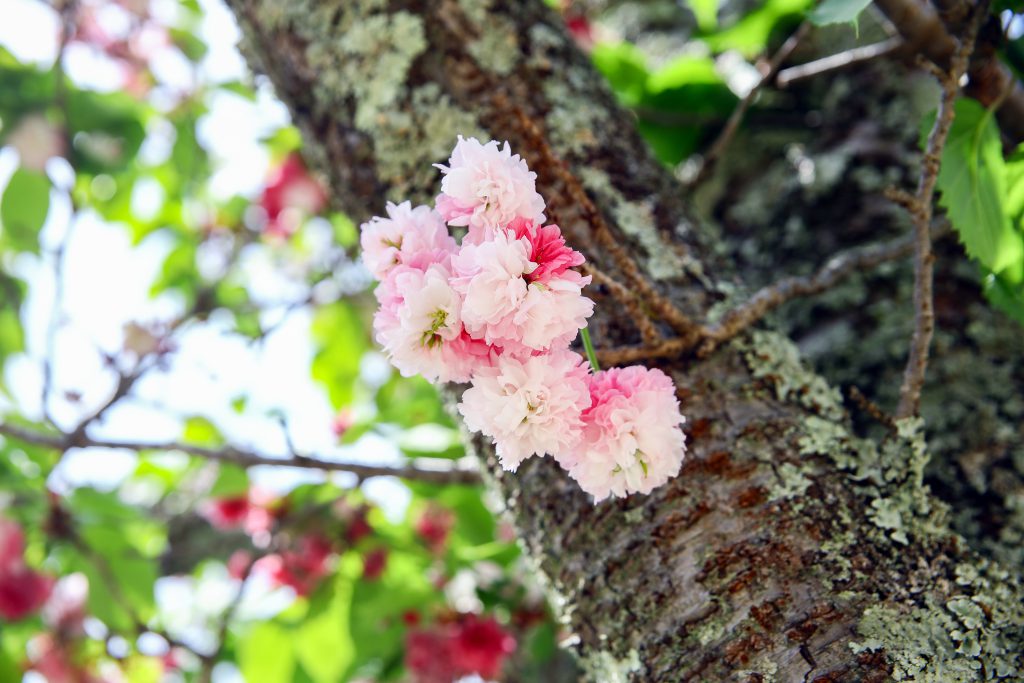
Nara no Yaezakura
This cherry blooms a little later on, from the latter part of April to early May. In bud, they are a deep red, and whilst the blossoms are rather compact, when they open they are a pale, whitish pink, tinged with darker cerise. They may be small, but the double cherry blossoms when massed are spectacular. If you can’t find them, we suggest heading for the main road side of the Noborioji car park. You are sure to enjoy the blossom here alongside a stone inscribed with the story explaining the origins of the cherry trees.
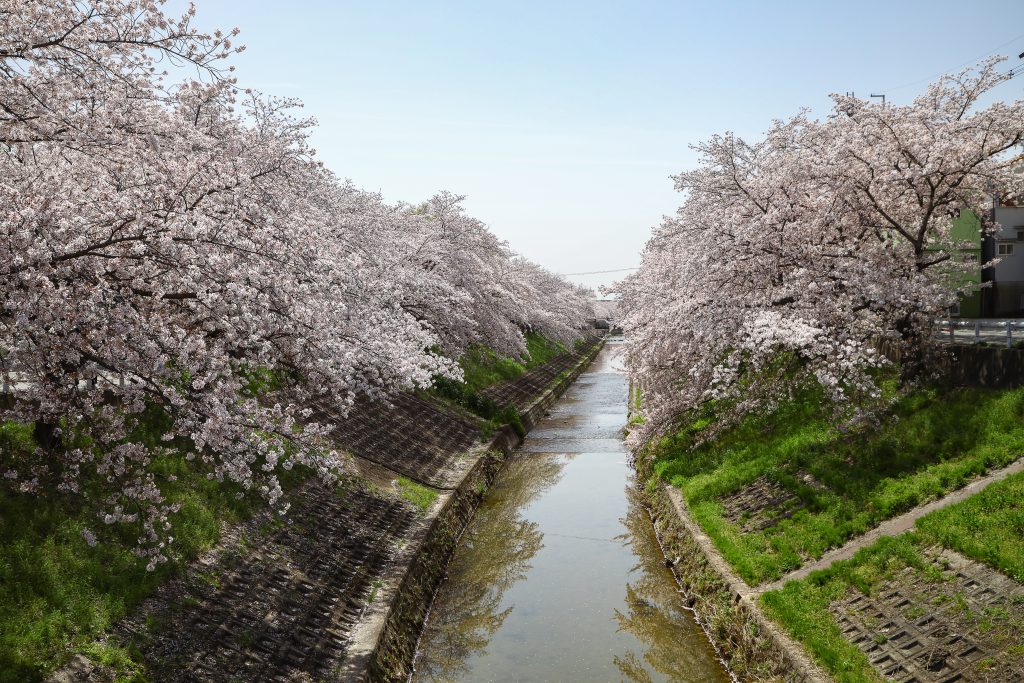
Rows of cherry trees along the Sahogawa River
The remarkable, 5km avenues of cherry trees lining the Sahogawa is cherished by the locals. There are 3 walking routes you can chose from and along which, on a sunny day, you can appreciate the blossom.
The first is a long route along which you can enjoy all the cherry trees along the Sahogawa. Starting from the Daibutsu Tetsudō Kinen Kōen park, about a 10-minute walk from Kintetsu Nara Station, head west along the Sahogawa. Go past the Kintetsu Shin-Omiya Station, aiming for the Nara Kenritsu Tosho Jōhōkan (Nara Prefectural Library and Information Centre). This is a worth a look, if you have time, and feel confident you have the energy to carry on and do the walk.
The second route is a short one, walking from the Daibutsu Tetsudō Kinen Kōen to Shin-Omiya Station (northeast side). The Sahogawa cherry trees started with the planting, by Nara City magistrate Kawaji Toshiakira, of Somei-yoshino (Yoshino cherry) trees. Known as the ‘Riverbank Cherry Trees’, five Somei-yoshino, planted about 170 years ago, still stand, lovingly tended by locals. The stands of cherry trees, as well as these older trees, are a sight well worth seeing. The Kawaji Sakura Matsuri (Kawaji Cherry Festival) is held from the last Saturday of March to the first Sunday of April, in the area between the Daibutsu Tetsudō Kinen Kōen and the JR Sahogawa iron bridge.
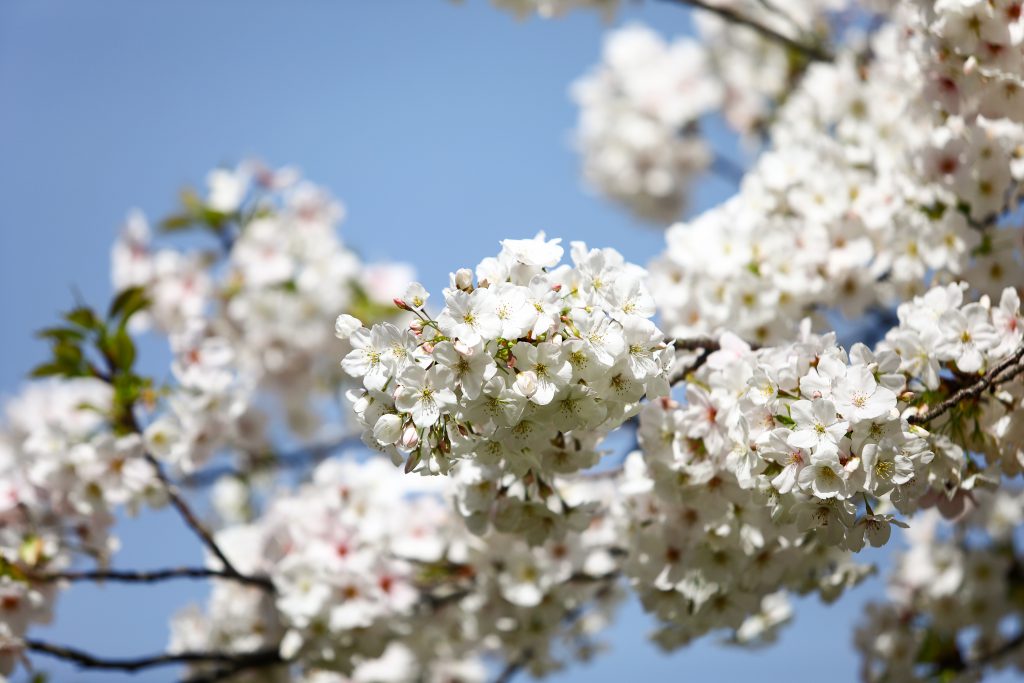
Rows of cherry trees continue from the Shin-Omiya Station west side. The third route is a short one where you can enjoy this west side area. After getting off the train at Shin-Omiya Station, head for the Nara Kenritsu Tosho Jōhōkan, a bustling, popular blossom viewing spot along the Sahogawa, enjoying the springtime atmosphere on the way. The Sahogawa Sakura Matsuri Tōkaka-e (Sahogawa Kawaji Cherry Festival Illuminations) is held between the JR Sahogawa iron bridge and Shin-Omiya Bridge) area, from the latter part of March to early April. The exquisite cherry blossom trees are truly beautiful in the evening, decorated with handmade paper lanterns which are lit with candles for the several days of the festival (except in wet weather).
If you walk a little further, from the Nara Park area westwards, you will come to the Nara Palace Site Historical Park, the site of the capital in the Nara Period (710-784). If travelling from in front of the Nara Prefectural Office Kenchō-mae/Nara Park Bus Terminal, or from Kintetsu Nara Station, we recommend you use the Omiyadōri route of the Gurutto buses which travels around the city. Whilst archaeological conservation work and reconstruction is being done in certain parts inside the park, the areas around the Nara Palace Site Museum and the Saekimon Gate, called the ‘Cherry Blossom Road’ by local people, are noted for their beautiful avenues of blossom.
URL: https://www.heijo-park.jp/en/(Nara Palace Site Historical Park)
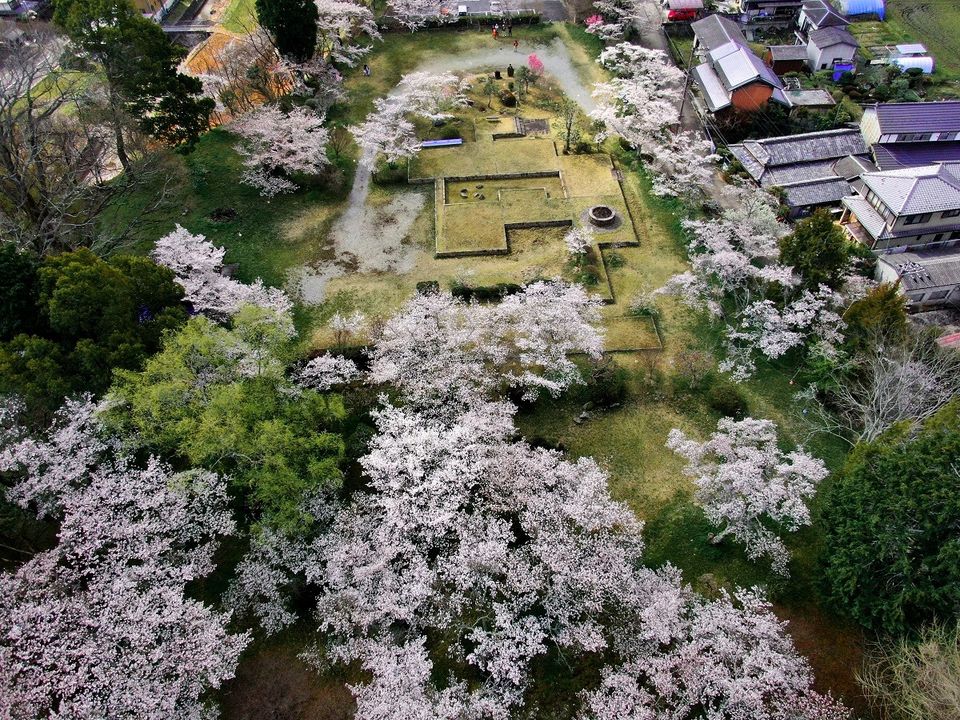
Photo by Yagyu Tourism Association
If you would like to enjoy cherry blossom in a far more peaceful place deep in the mountains, head for the Former Residence of the Yagyū Domain’s Chief Retainer, which has been made into historic park. You’ll be greeted here by no fewer than about 300 cherry trees.
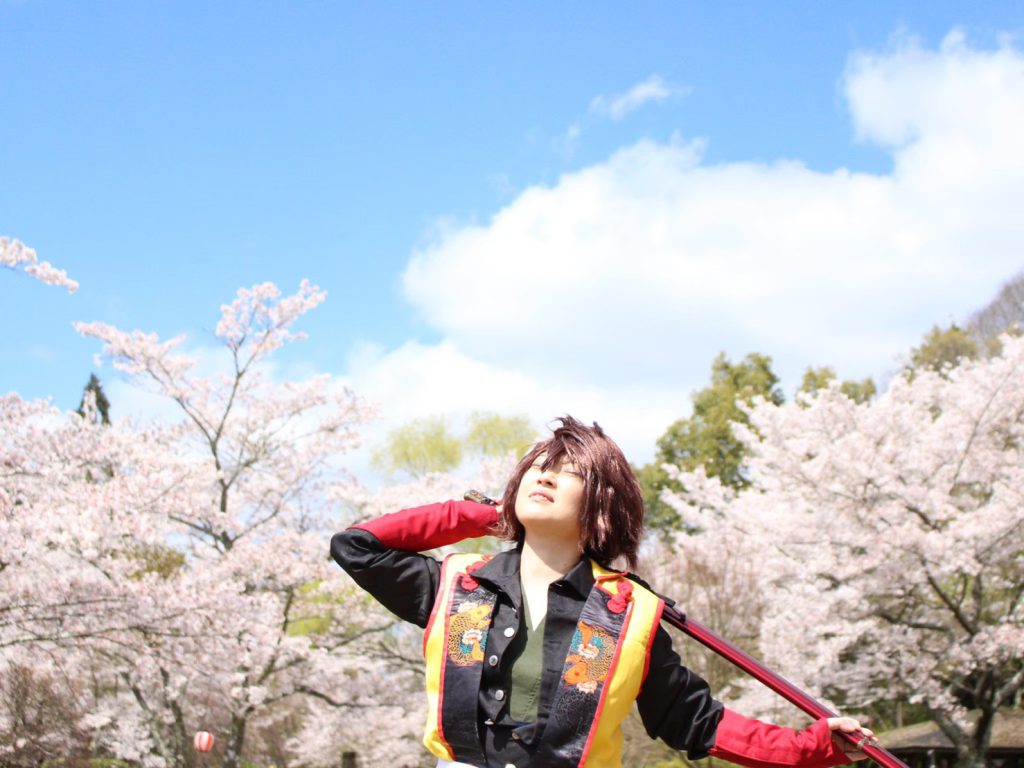
Photo by Yagyu Tourism Association
In fact, if you bring your own costume, the Yagyū Tourism Association will arrange ‘cosplay’ (costume re-enactment) photo opportunities in various spots as you walk around viewing the blossom in the Yagyū area (pre-booking required). Why not have a go …
URL: https://www.yagyukanko.com/(Yagyu Tourism Association)